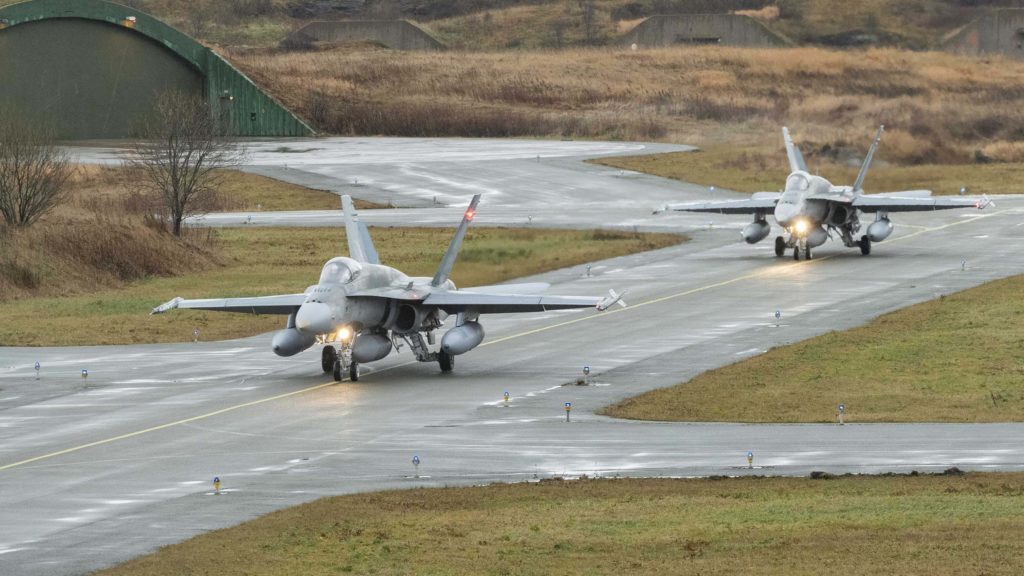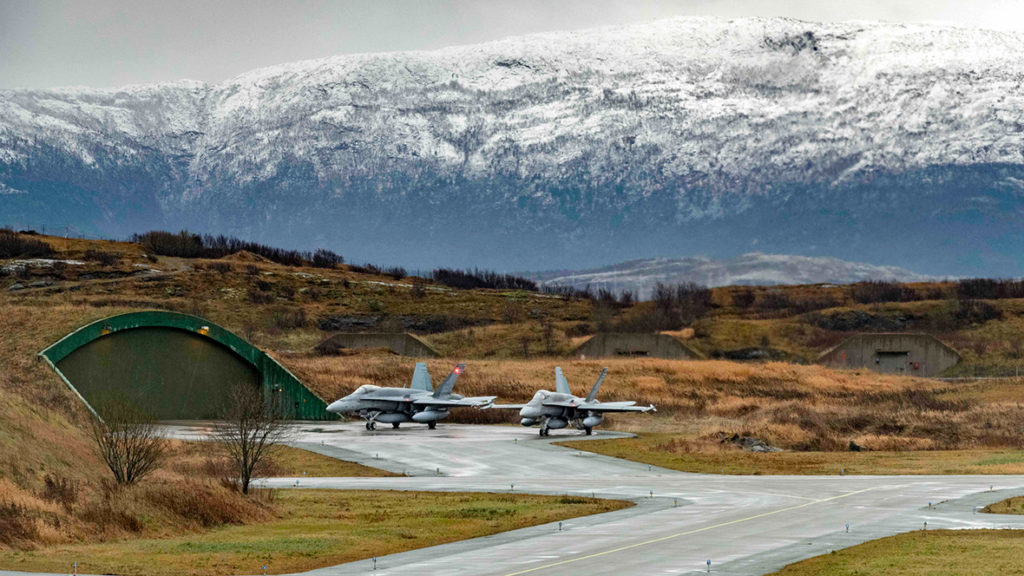Estimated reading time 9 minutes, 33 seconds.
Pilots and aircrews from across the Royal Canadian Air Force (RCAF) battled high winds, freezing rain, fog and a formidable enemy force in NATO’s largest exercise since the end of the Cold War.

Twelve aircraft and more than 270 RCAF personnel were part of a 2,000-strong Canadian Armed Forces contingent participating in the live portion of Exercise Trident Juncture 2018 in Norway the first week of November. Over 50,000 troops from 31 countries took part in an air, land and maritime scenario intended to demonstrate NATO’s collective defence and ability to move and interoperate large numbers of troops.
Though the setting was an Article 5 response to an invasion of a NATO member in the High North, the air portion took on its own script and tempo. With no contracted red air to provide the opposing force, each nation took a turn as the enemy.
“It [was] a fantastic training opportunity for the countries that aren’t used to operating in the Arctic,” said Col William Radiff, the RCAF Air Task Force commander. “There was an overarching concept, but I would argue it was more pertinent to the sea and land forces. We were more purple. Each mission was [about] what we were looking to achieve.”
Over 250 aircraft, including fighters, air-to-air refuelling tankers, electronic warfare, transport and helicopters participated in the exercise.
Radiff, the commanding officer of 3 Wing Bagotville, Que., oversaw an RCAF Air Task Force comprised of eight CF-188s from 401 Tactical Fighter Squadron in Cold Lake, Alta., a CC-150 Polaris tanker out of 8 Wing Trenton, Ont., two CP-140 Aurora anti-submarine and anti-surface warfare aircraft from 19 Wing Comox, B.C., and 14 Wing Greenwood, N.S., as well as their respective technicians and logisticians and a headquarters staff from the Air Expeditionary Wing in Bagotville. A CH-148 Cyclone embarked with (HMCS) Ville de Québec was part of the maritime component.
The fighters and the tanker were stationed in Bodø alongside French Mirage 2000s, Italian Eurofighters and Tornados, Swedish Gripens, Norwegian F-16s, Turkish F-16s, and Greek F-16s. The Auroras were based at Andøya Air Station on the most northern tip of Norway.
While the Arctic weather quickly became a factor in the fight, forcing exercise planners to adjust scenarios to adapt to the rules and restrictions each nation has for training flights, it was a far cry from the cold Canadian pilots experience on a typical winter day in Cold Lake.
“For us, it was mild,” said Radiff. “It was windy and raining some days, but it’s November. For the other nations, it was interesting for them to see the difference when working up north.”
Some air forces, for example, were unable to fly if freezing rain prevented the launch of search and rescue assets.
“We did lose missions to weather, but the wind was the single biggest factor,” he added, noting low visibility affected some missions while rough sea states forced others to be moved overland. “Some of the missions were changed significantly in order for them to be exercised because they were over the water.”
The only factor affecting the CF-188s were the high winds that at times exceeded the 35-knot limit of the Hornet chute during takeoff and landing — a restriction the RCAF places on the aircraft in peace time. “Operationally, we will go higher than that, but for training we don’t,” explained Radiff.

When not playing the enemy, the Hornets primarily conducted offensive counter air or deep strike missions. The former involved leading strike packages of allied fighters against enemy air assets while the latter simulated strikes against ground targets with GPS or laser-guided weapons.
“Those [were] the mission we sought from a training perspective,” said Radiff. “There were other countries that flew close air support in support of the army. We had volunteered to do some of those, but we didn’t end up flying on those days due to wind.”
The Hornets’ one day of tactical assistance to maritime operations was also cancelled for weather-related reasons.
The CC-150 tanker, meanwhile, provide refuelling to all but the F-16s throughout the exercise, while the CP-140 worked primarily with the Royal Canadian Navy and allies finding, tracking and targeting surface and subsurface fleets.
Trident Juncture emphasized the collective ability of NATO, Finland and Sweden to work together in a difficult environment. Radiff observed that fighter pilots are “all cut pretty much from the same cloth” and share a similar approach to missions, so there was little adjustment required to be effective. But even within NATO, there are notable differences in tactics and weapons and communications challenges, because not all aircraft are able to link into the same secure network architecture.
“We work together very well on an unclassified level,” he said. “We’re also very effective at integrating one another. It didn’t matter if you were leading a package of 40 airplanes … it was seamless because you would give them a task [and] you knew they were capable of carrying out that task.”
Though the eventual goal is a common operating picture all fighters can access and contribute to, he said the use of radios rather than digital systems at times was a good reminder for young pilots that brain power matters.
“In some ways, exercises like this are great because although you can see the picture that is being presented, it may not be all of the picture. So you need to continue to develop the picture in your brain and work all those pieces. Five years down the road when we are in Operation XYZ, if the link is jammed, we are going to need to use our brains to listen to the radio and develop the picture, so I think it’s good practice for our young pilots.”
While an enormous amount of planning was required to deliver such a large exercise, the RCAF aircrews required minimal pre-event preparation. As the current high readiness unit, 401 Squadron has been training extensively all year and needed only some night flying in larger formations “prior to getting here just to dust off some of those skill sets,” said Radiff.
The CP-140’s crews are in the process of reconstituting their anti-submarine warfare capabilities and were able to incorporate their ongoing training into the exercise. The CC-150 has been providing air-to-air refuelling for a range of fighters over Iraq since 2014.
Only the Air Task Force (ATF) headquarters, a relatively new concept for the RCAF, required some specialized collective training in theatre before the exercise began. Radiff, a skeptic of the air expeditionary wing concept when it was first developed, said it has evolved into a capability the Air Force can’t do without.
“I am a firm believer in the air expeditionary wing concept. I have now been part of several ATFs. The concept and the execution, the fact that it is scalable — you can go out the door with an HQ of four or 40 people, depending on the mission and assets — makes it very effective. I think we are a better Air Force because we have established this organization and now matured it to a point where I don’t know if you would want to deploy for a big operation without an ATF.”
Despite the periodic changes caused by the weather, Trident Juncture proved the capacity of NATO’s collective response. “It truly is [an exercise] where, when we work together, we truly are a stronger force than separate,” said Radiff.
In particular, he singled out the close bond between the RCAF and the host Norwegians. “[They are] a brother on the Arctic Council and we share a lot of the same characteristics in terms of small population, large country; we face the same existential threats … [and] we’ll regularly launch fighters to [defend our sovereignty]. It was very evident to me that a bond does exist and that we do share the same approach and values and morals towards peacemaking, peacekeeping and operations.”








